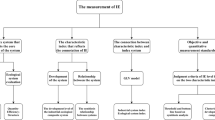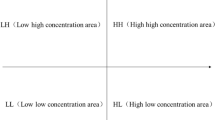Abstract
Based on the adaptive analysis paradigm, this paper constructs an evaluation index system and an evaluation model of the level of industrial ecology of a restricted development zone from the perspective of the industrial system and of the environmental system, and studies the spatial-temporal differentiation characteristics and the driving factors of the level of industrial ecology of the restricted development zone of the Shandong Province, China, by using a variety of measurement methods. The results show that: 1) In the temporal dimension, the level of industrial ecology of the research area increased from 2005 to 2017, while in the regional dimension, it was higher in the eastern coastal areas, followed by the northwestern area and the southwestern area; 2) In the spatial dimension, from 2005 to 2017 the level of industrial ecology of the research area had a clear spatial dependence, and the regional spatial agglomeration of the restricted development zones with similar industrial ecology levels become increasingly evident; 3) On the whole, the industrial ecology level in the study area had a clear spatial differentiation pattern, as it was higher in the north and in the east and lower in the south and in the west. Moreover, its evolution model changed from a ‘three-core driven model’ to a ‘spatial scattered mosaic distribution model’, and then to a ‘single-core driven model’; 4) Industrial ecology was positively correlated with economic development, foreign investment, science and technology, and negatively correlated with the government role, while industrial structure and environmental regulation failed to pass the statistical significance test.
Similar content being viewed by others
References
Brooks N, Adger W N, Kelly P M, 2005. The determinants of vulnerability and adaptive capacity at the national level and the implications for adaptation. Global Environmental Change, 15(2): 151–163. doi: https://doi.org/10.1016/j.gloenvcha.2004.12.006
Diao Shuo, Yuan Jiadong, Wu Yanyan, 2019. Performance evaluation of urban comprehensive carrying capacity of Harbin, Heilongjiang Province in China. Chinese Geographical Science, 29(4): 579–590. doi: https://doi.org/10.1007/s11769-019-1056-9
Gao Yingchun, Tong Lianjun, Ma Yanji et al., 2011. Environmental performance analysis of clean production and end-pipe treatment. Geographical Research, 30(3): 505–512. (in Chinese)
Guan Haoming, Liu Wenxin, Zhang Pingyu et al., 2018. Analyzing industrial structure evolution of old industrial cities using evolutionary resilience theory: a case study in Shenyang of China. Chinese Geographical Science, 28(3): 516–528. doi: https://doi.org/10.1007/s11769-018-0963-5
Guo Fuyou, Tong Lianjun, Wei Qiang et al., 2016a. Spatio-temporal difference and influencing factors of environmental adaptability assessment of industrial system in the Songhua River Basin of Jilin Province. Acta Geographica Sinica, 71(3): 458–470. (in Chinese)
Guo Fuyou, Lo K, Tong L J, 2016b. Eco-efficiency analysis of industrial systems in the Songhua River Basin: a decomposition model approach. Sustainability, 8(12): 1271. doi: https://doi.org/10.3390/su8121271
Guo Fuyou, Hou Ailing, Tong Lianjun et al., 2018. Spatio-temporal pattern and influencing factors of green development in the Northeast Restricted Development Zone since the Revitalization of the Northeast China. Economic Geography, 38(8): 58–66. (in Chinese)
Guo Fuyou, Tong Lianjun, Liu Zhigang et al., 2019. Spatial-temporal pattern and influencing factors of industrial ecology in Shandong province: Based on panel data of 17 cities. Geographical Research, 38(9): 2226–2238. (in Chinese)
Guo Yanhua, Ton Lianjun, Mei Lin, 2020. The effect of industrial agglomeration on green development efficiency in Northeast China since the revitalization. Journal of Cleaner Production, 258: 120584. doi: https://doi.org/10.1016/j.jclepro.2020.120584
Hu X H, Hassink R, 2017. Exploring adaptation and adaptability in uneven economic resilience: a tale of two Chinese mining regions. Cambridge Journal of Regions Economy and Society, 10(3): 527–541. doi: https://doi.org/10.1093/cjres/rsx012
Huang Zhibin, Wang Xiaohua, 2000. Economic analyses on industrial ecologilization and countermeasures thereof. East China Economic Management, 14(3): 7–8. (in Chinese)
Huang X, Huang X J, Liu M M et al., 2020. Spatial-temporal dynamics and driving forces of land development intensity in the Western China from 2000 to 2015. Chinese Geographical Science, 30(1): 16–29. doi: https://doi.org/10.1007/s11769-020-1095-2
Huber J, 2000. Towards industrial ecology: sustainable development as a concept of ecological modernization. Journal of Environmental Policy and Planning, 2(4): 269–285. doi: https://doi.org/10.1080/714038561
Korhonen J, Snäkin J P, 2005. Analysing the evolution of industrial ecosystems: concepts and application. Ecological Economics, 52(2): 169–186. doi: https://doi.org/10.1016/j.ecolecon.2004.07.016
Lambert A J D, Boons F A, 2002. Eco-industrial parks: stimulating sustainable development in mixed industrial parks. Technovation, 22(8): 471–484. doi: https://doi.org/10.1016/S0166-4972(01)00040-2
Li B, Jin X M, 2019. Spatio-temporal evolution of marine fishery industry ecosystem vulnerability in the Bohai Rim Region. Chinese Geographical Science, 29(6): 1052–1064. doi: https://doi.org/10.1007/s11769-019-1076-5
Li Liangang, Zhang Pingyu, Lo K et al., 2020. The evolution of regional economic resilience in the old industrial bases in China: a case study of Liaoning Province, China. Chinese Geographical Science, 30(2): 340–351. doi: https://doi.org/10.1007/s11769-020-1105-4
Liu Kai, Ren Jianlan, 2019. Spatial patterns of economic vulnerability of counties in Shandong province in the new normal. Journal of Shandong Teachers’ University (Humanities and Social Sciences), 64(1): 59–67. (in Chinese)
Liu Shuguang, Wang Lu, Yin Peng et al., 2018. Spatial-temporal characteristics and its driving factors of industrial ecology of prefecture level and above cities in China. Resource Development and Market, 34(11): 1488–1493, 1519. (in Chinese)
Liu Shuru, Han Shifang, 2017. Research on the evaluation of Western region industrial ecology. Ecological Economy, 33(3): 90–94, 99. (in Chinese)
Liu Wenxin, Zhang Pingyu, Ma Yanji, 2007. Environmental effects of industrial structure evolution of resources-based city: a case study of Anshan city. Journal of Arid Land Resources and Environment, 21(2): 17–21. (in Chinese)
Ma Yong, Liu Jun, 2015. Efficiency evaluation of regional industrial ecology of the Yangtze River middle reaches urban agglomerations. Economic Geography, 35(6): 124–129. (in Chinese)
Martey E, Al-Hassan R M, Kuwornu J K M, 2012. Commercialization of smallholder agriculture in Ghana: a Tobit Regression Analysis. African Journal of Agricultural Research, 7(14): 2131–2141. doi: https://doi.org/10.5897/AJAR11.1743
National Bureau of Statistics of China, 2005 -2018. China City Statistic Yearbook. Beijing: China Statistics Press. (in Chinese)
National Bureau of Statistics of Shandong, 2005–2018. Shandong Statistic Yearbook. Beijing: China Statistics Press. (in Chinese)
Patchell J, Hayter R, 2013. Environmental and evolutionary economic geography: time for EEG2? Geografiska Annaler: Series B, Human Geography, 95(2): 111–130. doi: https://doi.org/10.1111/geob.12012
Kuai P, Li W, Cheng R H et al., 2015. An application of system dynamics for evaluating planning alternatives to guide a green industrial transformation in a resource-based city. Journal of Cleaner Production, 104: 403–412. doi: https://doi.org/10.1016/j.jclepro.2015.05.042
Ren Lijun, Shang Jincheng, 2005. Ecological rationality assessment of industrial structure in Shandong Province. Scientia Geographica Sinica, 25(2): 215–220. (in Chinese)
Shao S, Luan R R, Yang Z B et al., 2016. Does directed technological change get greener: empirical evidence from Shanghai’s industrial green development transformation. Ecological Indicators, 69: 758–770. doi: https://doi.org/10.1016/j.ecolind.2016.04.050
Smit B, Wandel J, 2006. Adaptation, adaptive capacity and vulnerability. Global Environmental Change, 16(3): 282–292. doi: https://doi.org/10.1016/j.gloenvcha.2006.03.008
Smith R L, Sengupta D, Takkellapati S et al., 2015. An industrial ecology approach to municipal solid waste management: methodology. Resources, Conservation and Recycling, 104: 311–316. doi: https://doi.org/10.1016/j.resconrec.2015.04.005
Tan J T, Lo K, Qiu F D et al., 2020. Regional economic resilience of resource-based cities and influential factors during economic crises in China. Growth and Change, 51(1): 362–381. doi: https://doi.org/10.1111/grow.12352
Tong Lianjun, Song Ya’nan, Han Ruiling et al., 2012. Industrial environmental efficiency of costal economic belt in Liaoning Province. Scientia Geographica Sinica, 32(3): 294–300. (in Chinese)
von Hauff M, Wilderer P A, 2008. Industrial ecology: engineered representation of sustainability. Sustainability Science, 3(1): 103–115. doi: https://doi.org/10.1007/s11625-007-0037-6
Wang D L, Zheng J P, Song X F et al., 2017. Assessing industrial ecosystem vulnerability in the coal mining area under economic fluctuations. Journal of Cleaner Production, 142: 4019–4031. doi: https://doi.org/10.1016/j.jclepro.2016.10.049
Wang Guoxia, Shi Xiaowei, Cui Haiyan et al., 2020. Impacts of migration on urban environmental pollutant emissions in China: a comparative perspective. Chinese Geographical Science, 30(1): 45–58. doi: https://doi.org/10.1007/s11769-020-1096-1
Wang Xinmin, Ding Hao, 2017. Technology spillout among industries, energy structural adjustment and industrial ecologization. Soft Science, 31(6): 10–14. (in Chinese)
Xu Lingxing, Yang Dewei, Gao Xueli et al., 2019. Evaluating the network nexus and efficiency of circular economy: a case study of Jiaoyang eco-industrial park. Acta Ecologica Sinica, 39(12): 4328–4336. (in Chinese)
Yan Jianjun, Xu Lei, Li Yang, 2017. The development path of Hunan’s eco-industrial system under restrictions of resource and environment. Economic Geography, 37(6): 183–189. (in Chinese)
Zhang Guojun, Wang Juehan, Zhuang Dachang, 2018. The characteristics and driving forces of spatial and temporal evolution of industrial ecology in Guangzhou. Geographical Research, 37(6): 1070–1086. (in Chinese)
Zhao Danyang, Tong Lianjun, Guo Fuyou et al., 2016. Industrial ecological development of Jilin Province, Northeast China based on structure optimization vision. Chinese Journal of Applied Ecology, 27(9): 2933–2940. (in Chinese)
Zuindeau B, 2007. Régulation school and environment: theoretical proposals and avenues of research. Ecological Economics, 62(2): 281–290. doi: https://doi.org/10.1016/j.ecolecon.2006.12.018
Author information
Authors and Affiliations
Corresponding author
Additional information
Foundation item
Under the auspices of National Natural Science Foundation of China (No. 41801105, 41771138), National Natural Science Foundation of Shandong (No. ZR2018BD002), Social Science Planning Research Project of Shandong (No. 18DJJJ14)
Rights and permissions
About this article
Cite this article
Guo, F., Gao, S., Tong, L. et al. Spatio-temporal Differentiation and Driving Factors of Industrial Ecology of Restricted Development Zone from Adaptive Perspective: A Case Study of Shandong, China. Chin. Geogr. Sci. 31, 329–341 (2021). https://doi.org/10.1007/s11769-021-1184-x
Received:
Accepted:
Published:
Issue Date:
DOI: https://doi.org/10.1007/s11769-021-1184-x




